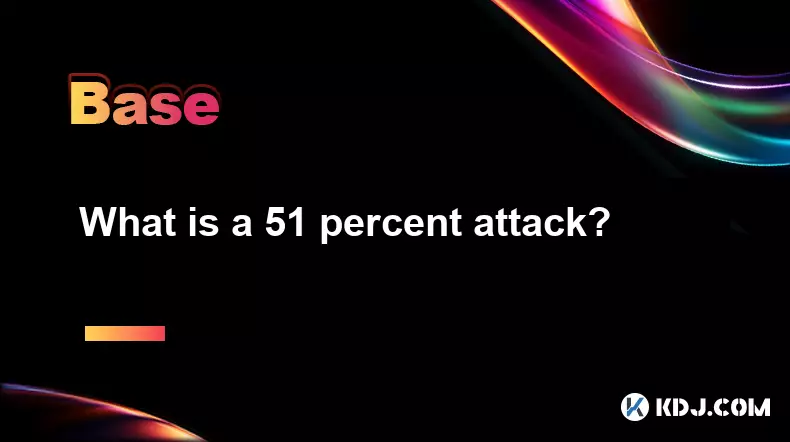-
 bitcoin
bitcoin $102877.190955 USD
1.88% -
 ethereum
ethereum $3430.435064 USD
4.52% -
 tether
tether $0.999264 USD
-0.05% -
 xrp
xrp $2.307310 USD
4.49% -
 bnb
bnb $987.740692 USD
3.82% -
 solana
solana $161.947760 USD
3.97% -
 usd-coin
usd-coin $0.999712 USD
-0.05% -
 tron
tron $0.292810 USD
2.93% -
 dogecoin
dogecoin $0.179738 USD
10.70% -
 cardano
cardano $0.580716 USD
8.75% -
 hyperliquid
hyperliquid $42.463448 USD
8.40% -
 chainlink
chainlink $15.763437 USD
7.05% -
 zcash
zcash $649.595636 USD
17.21% -
 bitcoin-cash
bitcoin-cash $511.610261 USD
7.19% -
 stellar
stellar $0.292537 USD
7.91%
What is a 51 percent attack?
A 51% attack allows control of a blockchain’s network, enabling double-spending and transaction censorship, though it cannot steal private funds directly.
Sep 11, 2025 at 07:18 am

Understanding the Concept of a 51% Attack
1. A 51% attack refers to a scenario in which a single entity or group gains control over more than half of a blockchain network's mining power or hash rate. This dominance allows the attacker to manipulate the blockchain in ways that undermine its integrity and trustworthiness. In proof-of-work systems, computational power determines influence, and majority control leads to significant leverage.
2. Once an entity controls over 50% of the network's hash rate, they can prevent new transactions from gaining confirmations. They can halt payments between users, effectively freezing fund transfers. This disruption damages the reliability of the cryptocurrency as a functional medium of exchange.
3. The attacker can also reverse transactions they made while in control. This enables double-spending, where the same coins are spent multiple times. For instance, a user could send coins to an exchange, receive fiat in return, then reverse the original transaction, keeping both the coins and the cash.
4. While a 51% attack cannot create new coins out of thin air or steal funds directly from unrelated addresses, the ability to rewrite transaction history poses a severe threat to confidence in the network. Users and investors may lose trust, leading to price volatility and withdrawal from the ecosystem.
5. Smaller blockchain networks are more vulnerable due to lower overall hash rates. Larger networks like Bitcoin are highly resistant because acquiring such vast computational power would be prohibitively expensive and logistically challenging. However, the theoretical risk remains, especially for newer or less established cryptocurrencies.
Real-World Instances of 51% Attacks
1. In 2018, the cryptocurrency Verge (XVG) suffered a 51% attack where attackers exploited time manipulation vulnerabilities in its mining algorithm. Over 35 million XVG were mined in a short span, leading to a massive inflationary event and significant loss of market value.
2. Ethereum Classic (ETC) experienced multiple 51% attacks in 2019 and 2020. Attackers were able to reorganize the blockchain and double-spend over $1 million worth of ETC. These incidents raised concerns about the long-term viability of smaller proof-of-work chains.
3. Bitcoin Gold (BTG), a Bitcoin fork, was hit by a 51% attack in 2018 and again in 2020. The attackers reversed transactions and double-spent approximately $70,000 in BTG during the first incident. The recurrence highlighted ongoing security flaws in minority hash rate networks.
4. These attacks often go unnoticed until significant damage is done. Exchanges may not immediately detect chain reorganizations, allowing attackers to withdraw funds before the reversal is identified. This delay increases the financial impact on platforms and users alike.
5. The frequency of such attacks on smaller chains has led some exchanges to increase confirmation requirements or delist vulnerable cryptocurrencies. This response reflects a growing awareness of network security as a prerequisite for market participation.
How Networks Defend Against Majority Control
1. Increasing the total hash rate of a network makes it more expensive and difficult to execute a 51% attack. Projects often encourage broader miner participation and support mining decentralization to strengthen resistance.
2. Some blockchains implement checkpointing, where certain blocks are hardcoded into the software. This prevents reorganization beyond those points, limiting the window for transaction reversal.
3. Algorithm diversity helps reduce the risk of mining centralization. By using unique hashing algorithms, networks avoid competition with larger chains and attract dedicated mining communities. This separation enhances security through specialization.
4. Adopting hybrid consensus models, such as proof-of-stake combined with proof-of-work, can significantly reduce the feasibility of hash rate takeovers. These models shift influence from computational power to economic stake, altering the incentive structure for attackers.
5. Monitoring services now exist to detect unusual chain reorganizations or hash rate spikes. These tools alert developers and exchanges in real time, enabling faster response to potential attacks and minimizing financial exposure.
Frequently Asked Questions
What happens to a cryptocurrency’s price after a 51% attack?Market confidence typically drops following a confirmed 51% attack. The price often declines sharply as investors perceive increased risk and instability. Recovery depends on the response from developers and exchanges.
Can a 51% attack steal my private funds?No, a 51% attack cannot access private keys or directly steal funds from wallets. It only allows manipulation of transaction ordering and confirmation, primarily enabling double-spending of the attacker’s own coins.
Is Bitcoin vulnerable to a 51% attack?Theoretically yes, but practically it is extremely unlikely. The amount of computational power required to overpower Bitcoin’s network is immense, and the cost would far exceed any potential gain from an attack.
How can exchanges protect themselves from 51% attacks?Exchanges can enforce longer confirmation times for deposits, especially for smaller proof-of-work coins. They can also integrate real-time blockchain monitoring tools to detect chain reorganizations and suspend withdrawals during suspicious activity.
Disclaimer:info@kdj.com
The information provided is not trading advice. kdj.com does not assume any responsibility for any investments made based on the information provided in this article. Cryptocurrencies are highly volatile and it is highly recommended that you invest with caution after thorough research!
If you believe that the content used on this website infringes your copyright, please contact us immediately (info@kdj.com) and we will delete it promptly.
- Ripple (XRP) in 2026: Hold or Fold? A Look at XRP's Future and Emerging DeFi Alternatives
- 2025-11-08 18:35:01
- Zcash ZEC Coin Price Explosion: From Privacy Niche to Center Stage
- 2025-11-08 18:55:01
- Berachain Price Prediction: Navigating the Honeycomb Hype in Crypto
- 2025-11-08 18:55:01
- Arthur Hayes, Gold, and Bitcoin: A Modern Monetary Trinity?
- 2025-11-08 19:15:01
- Shiba Inu's Next Move: Navigating a Shifting Market
- 2025-11-08 19:20:01
- Pakistan's Crypto Crossroads: Balancing Opportunity with Asset-Backed Realities
- 2025-11-08 19:20:01
Related knowledge

How does a crypto insurance protocol work?
Nov 08,2025 at 12:39am
Understanding Crypto Insurance Protocols1. A crypto insurance protocol operates by offering financial protection against losses incurred from digital ...

What is an "exploit" versus a "hack" in the context of smart contracts?
Nov 09,2025 at 12:40am
Understanding Exploits in Smart Contracts1. An exploit refers to the utilization of a known vulnerability within a smart contract’s code to gain unint...

What is a decentralized storage network and how does it compare to cloud services?
Nov 07,2025 at 11:59pm
Understanding Decentralized Storage Networks1. A decentralized storage network distributes data across a peer-to-peer infrastructure rather than relyi...

What is a factory contract and how is it used to deploy other contracts?
Nov 08,2025 at 04:20am
Understanding Factory Contracts in Blockchain Development1. A factory contract is a smart contract designed to create and deploy other smart contracts...

What is "alpha" in crypto and how do people find it?
Nov 08,2025 at 06:19pm
Understanding Alpha in the Cryptocurrency Space1. In the context of cryptocurrency, 'alpha' refers to valuable, non-public information or insights tha...

What is a "capital efficiency" in DeFi and how is it improved?
Nov 09,2025 at 01:40am
Understanding Capital Efficiency in DeFi1. Capital efficiency in decentralized finance (DeFi) refers to the ability of financial protocols and systems...

How does a crypto insurance protocol work?
Nov 08,2025 at 12:39am
Understanding Crypto Insurance Protocols1. A crypto insurance protocol operates by offering financial protection against losses incurred from digital ...

What is an "exploit" versus a "hack" in the context of smart contracts?
Nov 09,2025 at 12:40am
Understanding Exploits in Smart Contracts1. An exploit refers to the utilization of a known vulnerability within a smart contract’s code to gain unint...

What is a decentralized storage network and how does it compare to cloud services?
Nov 07,2025 at 11:59pm
Understanding Decentralized Storage Networks1. A decentralized storage network distributes data across a peer-to-peer infrastructure rather than relyi...

What is a factory contract and how is it used to deploy other contracts?
Nov 08,2025 at 04:20am
Understanding Factory Contracts in Blockchain Development1. A factory contract is a smart contract designed to create and deploy other smart contracts...

What is "alpha" in crypto and how do people find it?
Nov 08,2025 at 06:19pm
Understanding Alpha in the Cryptocurrency Space1. In the context of cryptocurrency, 'alpha' refers to valuable, non-public information or insights tha...

What is a "capital efficiency" in DeFi and how is it improved?
Nov 09,2025 at 01:40am
Understanding Capital Efficiency in DeFi1. Capital efficiency in decentralized finance (DeFi) refers to the ability of financial protocols and systems...
See all articles





















![The Graph Price Prediction [GRT Crypto Price News Today] The Graph Price Prediction [GRT Crypto Price News Today]](/uploads/2025/11/07/cryptocurrencies-news/videos/690d4df44fe69_image_500_375.webp)



















































